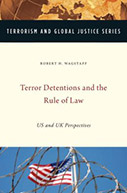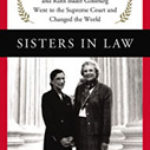Terror Detentions and the Rule of Law: US and UK Perspectives

Author: Robert H. Wagstaff
Publisher: New York; Oxford, UK: Oxford University Press, 2014.
Reviewer: Alec D. Walen | March 2015
The struggle (or “war”) that many countries have waged against terrorist groups, a struggle that took on special urgency after the attacks on 9/11, has raised difficult questions about what tools are effective in combating these groups, and also about whether certain effective tools might nonetheless be morally beyond the pale. Many have argued that captured suspected terrorists (STs) need not be tried for crimes; rather, if trials are too costly or too risky, then STs should be given a different (less costly and less risky to the detaining power) kind of hearing to determine if they were indeed engaged in terrorist activities, and if found to have done so, then they should be detained, possibly for many years, as enemy combatants. Many of those same people also supported “enhanced interrogation” of those detainees, arguing that those measures were both effective and permissible.
At the same time, many have been critical of those policies. The critics have tended to argue that detention without a criminal trial was not only unnecessary for security, but that it actually was a recruiting tool for terrorist organizations, thereby undermining security. And, as views about effectiveness and morality tend to go hand in hand, these same critics have tended to argue that long-term preventive detention (LTPD) of STs was also illegal and immoral. In addition, they argued that “enhanced interrogation” techniques should be called by their true name: torture. And they argued that torture is both ineffective and beyond the pale.
Robert Wagstaff, focusing on the actions of the United States and the United Kingdom, joins the fray on the side of the critics. His particular contribution is to argue that the rule of law provides a particularly helpful framework for understanding what is wrong with the detention policies of both countries, and the interrogation policies adopted by the United States and at the very least not sufficiently criticized by the government of the United Kingdom. He argues that LTPD of STs without criminal conviction establishing that they are indeed terrorists runs counter to the core principles of the rule of law. And he argues that the interrogation techniques employed by the United States under the Bush administration, either directly or through rendition to other countries that would do the dirty work for the United States, was not only ineffective but was also torture, and as such clearly incompatible with the rule of law.
Wagstaff makes some compelling points. He argues quite plausibly (1) that what Bush administration called “enhanced interrogation techniques” included torture (15-31), and that torture is never an effective means of gathering information (25-26, 93-99); (2) that the rule of law should include the separation of powers, judicial review of legislation and executive action, the provision of due process, and substantive commitments to values like equality before the law and the protection of fundamental human rights (114-132); and (3) that judges need to have a role in enforcing the rule of law, even when national security is at stake (passim, but especially chapter 7).
None of these points is particularly original, however, and the book is unfortunately plagued by a number of serious weaknesses. Most importantly, Wagstaff does not approach the topic with a fair-minded, scholarly attitude, but with an obvious disdain for those who disagree—and I say this as someone who mostly agrees with his substantive conclusions. This leads him often to unfairly represent the views of those with whom he disagrees, and to neglect arguments that would be made on the other side of the debate.
One core substantive failure in Wagstaff’s argument concerns his claim that there is no need to use the war paradigm when confronting terrorism. He supports this claim by appealing to the lessons that the United Kingdom learned, in Northern Ireland, in the 1970s — namely, that using the war paradigm is counterproductive. (219-222) However, even if this lesson was well learned in the context of Northern Ireland, it is not obvious that the lesson generalizes to all contexts. That is, it is not so clear that the domestic fight against terrorism in Northern Ireland is a good analogy for the fight against the Taliban, al Qaeda, its offshoots, and the emergent ISIS and its affiliated groups. The British could use police in Northern Ireland; the United States cannot do the same in Yemen, Pakistan, or many other places where these groups operate. This is a difference that seems to have completely escaped Wagstaff’s notice.
A related substantive problem with Wagstaff’s argument is that his emphasis on using the criminal model for dealing with STs rests on the assumption that war is clearly different from the struggle against STs. Based on that assumption, he takes the Bush administration to task for misusing the war paradigm: “By utilizing the war paradigm, terrorists become enemies of the state, and the military can take the lead. There is no need to wait for hard evidence, probable cause, or even reasonable suspicion before taking action.” (219) But one cannot simply dismiss the thought that non-state actors can wage war—as they do in any civil war—and that the state may sometimes have to use war-like measures to promote security. To be plausible, one must take a more functionalist, less formalistic, approach to the difference between war and not-war than Wagstaff is willing to entertain.
There is one way in which the book had some utility for me. I learned, and other readers might learn, something about the history of detention and torture, about the range of prominent contemporary commentators writing on both, and about American and British law, international human rights law, and humanitarian law relating to both. But even in that regard, the book is seriously flawed and can only be recommended with a strong caveat. Judging from the material that I knew well before reading the book, Wagstaff is an unreliable reporter of the law and of scholars with whom he disagrees. This is a serious accusation; accordingly, I will back it up with four examples.
Example 1: In his discussion of the dissent written by Justice Roberts (for four dissenters) in Boumediene v. Bush, 553 U.S. 723 (2008), Wagstaff summarizes what he takes Roberts to think about the rule of law: it is “optional and can be overridden or ignored by the will of the people in accordance with the fears and biases of the moment.” (184) This is a grossly unfair caricature of Roberts’s position. Roberts argued that combatant status review tribunals (CSRT) and the appeals process available to one who had been determined by a CSRT to be an enemy combatant, provided an adequate substitute for habeas corpus. This was not a frivolous position. The detainees had the right, under the Detainee Treatment Act (DTA) of 2005, to challenge their status on the grounds that the hearings were unconstitutional. No detainee had actually gone through the process at the time the Court agreed to hear the Boumediene petition. The best justification for finding that the protections under the DTA were inadequate was not that they were glaringly, obviously inadequate. It was a sense of impatience with a system of CSRTs that seemed, as a matter of fact, to be running in an incompetent and biased way. But having more patience with the system Congress designed is hardly a fair basis for the accusation that writer thinks the rule of law “optional.”
Example 2: In his discussion of the dissent written by Justice Scalia in Boumediene (written also for four dissenters, not the three that Wagstaff lists), Wagstaff complains that Scalia never explains “[h]ow or when the detainees were adjudicated to become ‘enemies.’” (185) But, of course, the answer is that they were found to be “enemies” by being found by a CSRT to be combatants fighting with nations or organizations responsible for the 9/11 attacks. Wagstaff objects that they cannot be enemies because “[n]one of the countries in which the detainees are citizens are at war with the United States.” (id) This formalistic definition of “enemy” is not only far too flimsy a basis for rejecting Scalia’s position, it could easily mislead a naïve reader into thinking that Scalia must have endorsed some more substantive failure to make an important finding.
Example 3: Scalia correctly points out in his Boumediene dissent that no nonresident alien had ever before been held to enjoy constitutional rights under the U.S. Constitution. Wagstaff seems to think that this is obviously the wrong position, and that the right position, the one adopted by the majority, is that nonresident aliens have constitutional rights whenever the United States has “de facto sovereignty with effective control.” (189) That is, however, explicitly not the test used by the majority in Boumediene. The majority adopted a three-part functional test in which de facto control was only one element, neither necessary nor sufficient for extending constitutional rights to the detainees.
Example 4: Wagstaff criticizes the D.C. Circuit court, in a case called al-Bihani v. Obama, 590 F.3d 866 (D.C. Cir. 2010), for “ignor[ing] the Supreme Court’s prior ruling in Hamdan that the procedures must follow those . . . required by Common Article 3 of the Geneva Conventions and of Article 75 of Protocol 1, which dictates that procedures must be UCMJ compliant or the equivalent.” (246). This is doubly obtuse. First, Hamdan was a statutory case, and the statutory basis for it was erased when Congress passed and President Bush signed the Military Commissions Act of 2006. Second, Hamdan concerned a military commission, whose job was to try detainees for war crimes; al-Bihani concerned a habeas petition for a detainee who was not being tried for crimes but who had been found to be an enemy combatant by a CSRT. They are simply different kinds of procedures, and to pretend that the Court’s holding on one is relevant to another, without some pretty creative argument supporting the connection, is, if not nonsense, then completely misleading.
Those are just some examples of how Wagstaff’s reporting on the law is not reliable. I could offer many others. They all seem to reflect a certain dismissiveness both of those arguing on the other side, and of the possibility that the struggle against terrorism, particularly in a global context, might not be just like policing crime domestically.
Finally, I feel compelled to add that the book is poorly written. It reads, for the most part, like an annotated scrapbook. Rather than being his own writing, with quotations used as needed to support a point, it is largely a collection of quotations, with his own text stitching it together. In addition, while it is well organized on the chapter level, the subchapter organization is a mess, often jumping between topics, and across time periods.
One hates to be too harsh on a young scholar—Wagstaff has just recently finished his Ph.D. at Oxford—but the unfortunate truth is that this is simply not a good book.
Alec D. Walen holds a joint appointment in Law, Philosophy, and Criminal Justice at Rutgers University


